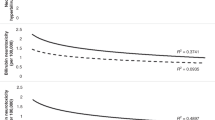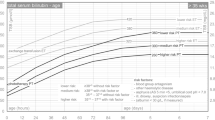Abstract
Objective
To determine the incidence and etiology of extreme neonatal hyperbilirubinemia, defined as total serum bilirubin (TSB) ≥450 µmol/L, and kernicterus spectrum disorder (KSD) in Denmark between 2000 and 2015.
Study design
We identified all infants born between 01.01.2000 and 31.12.2015 with TSB ≥450 µmol/L, ratio of conjugated to TSB <0.30, gestational age ≥35 weeks, and postnatal age ≤4 weeks, using Danish hospitals’ laboratory databases.
Result
We included 408 infants. The incidence of extreme neonatal hyperbilirubinemia among infants with gestational age ≥35 weeks was 42/100,000 during the study period with a seemingly decreasing incidence between 2005 and 2015. Twelve of the 408 infants developed KSD, (incidence 1.2/100,000) Blood type ABO isohemolytic disease was the most common explanatory etiology.
Conclusions
Our study stresses the importance of a systematic approach to neonatal jaundice and ongoing surveillance of extreme neonatal hyperbilirubinemia and KSD.
This is a preview of subscription content, access via your institution
Access options
Subscribe to this journal
Receive 12 print issues and online access
$259.00 per year
only $21.58 per issue
Buy this article
- Purchase on Springer Link
- Instant access to full article PDF
Prices may be subject to local taxes which are calculated during checkout

Similar content being viewed by others
References
American Academy of Pediatrics Subcommittee on Hyperbilirubinemia. Management of hyperbilirubinemia in the newborn infant 35 or more weeks of gestation. Pediatrics. 2004;114:297–316.
Volpe J Bilirubin and Brain Injury. Neurology of the Newborn. 5. Edition ed. Philadelphia: Saunders Elsevier; 2008. p. 619–51.
Hansen TW, Nietsch L, Norman E, Bjerre JV, Hascoet JM, Mreihil K, et al. Reversibility of acute intermediate phase bilirubin encephalopathy. Acta Paediatr. 2009;98:1689–94.
Le Pichon J, Riordan S, Watchko J, Shapiro S. The neurological sequelae of neonatal hyperbilirubinemia: definitions, diagnosis and treatment of the kernicterus spectrum disorders (KSDs). Curr Pediatr Rev. 2017;13:199–209.
Iskander I, Gamaleldin R, El Houchi S, El Shenawy A, Seoud I, El Gharbawi N, et al. Serum bilirubin and bilirubin/albumin ratio as predictors of bilirubin encephalopathy. Pediatrics. 2014;134:1330–9.
Manning D, Todd P, Maxwell M, Jane Platt M. Prospective surveillance study of severe hyperbilirubinaemia in the newborn in the UK and Ireland. Arch Dis Child. 2007;92:342–6.
Sgro M, Campbell D, Barozzino T, Shah V. Acute neurological findings in a national cohort of neonates with severe neonatal hyperbilirubinemia. J Perinatol. 2011;31:392–6.
Weng Y, Chiu Y, Cheng S, Hsieh M. Risk assessment for adverse outcome in term and late preterm neonates with bilirubin values of 20 mg/dL or more. Am J Perinatol. 2011;28:405–12.
Ebbesen F, Bjerre JV, Vandborg PK. Relation between serum bilirubin levels ≥450 µmol/L and bilirubin encephalopathy; a Danish population-based study. Acta Paediatr. 2012;101:384–9.
Ebbesen F. Recurrence of kernicterus in term and near-term infants in Denmark. Acta Paediatr. 2000;89:1213–7.
Ebbesen F, Andersson C, Verder H, Grytter C, Pedersen-Bjergaard L, Petersen JR, et al. Extreme hyperbilirubinaemia in term and near-term infants in Denmark. Acta Paediatr. 2005;94:59–64.
Bjerre JV, Petersen JR, Ebbesen F. Surveillance of extreme hyperbilirubinaemia in Denmark. A method to identify the newborn infants. Acta Paediatr. 2008;97:1030–4.
Vandborg PK, Hansen BM, Greisen G, Mathiasen R, Kasper F, Ebbesen F. Follow-up of extreme neonatal hyperbilirubinaemia in 5- to 10-year-old children: a Danish population-based study. Dev Med Child Neurol. 2015;57:378–84.
Vandborg PK, Hansen BM, Greisen G, Jepsen M, Ebbesen F. Follow-up of neonates with total serum bilirubin levels ≥25 mg/dL: a Danish population-based study. Pediatrics. 2012;130:61–6.
Rosenthal P. Direct bilirubin measurements in term newborns-a waste of time and money? J Pediatr Gastroenterol Nutr. 1992;15:220–1.
Govaert P, Lequin M, Swarte R, Robben S, De Coo R, Weisglas-Kuperus N, et al. Changes in globus pallidus with (pre)term kernicterus. Pediatrics. 2003;112:1256–63.
Herschel M, Karrison T, Wen M, Caldarelli L, Baron B. Isoimmunization is unlikely to be the cause of hemolysis in ABO-incompatible but direct antiglobulin test-negative neonates. Pediatrics. 2002;110:127–30.
Sgro M, Kandasamy S, Shah V, Ofner M, Campbell D. Severe neonatal hyperbilirubinemia decreased after the 2007 Canadian guidelines. J Pediatr. 2016;171:43–7.
McGillivray A, Polverino J, Badawi N, Evans N. Prospective surveillance of extreme neonatal hyperbilirubinemia in Australia. J Pediatr. 2016;168:82–7.
Gotink MJ, Benders MJ, Lavrijsen SW, Rodrigues Pereira R, Hulzebos CV, Dijk PH. Severe neonatal hyperbilirubinemia in the Netherlands. Neonatology. 2013;104:137–42.
Bhutani VK, Meng NF, Knauer Y, Danielsen BH, Wong RJ, Stevenson DK, et al. Extreme hyperbilirubinemia and rescue exchange transfusion in California from 2007 to 2012. J Perinatol. 2016;36:853–7.
Zoubir S, Mieth R, Berrut S, Roth-Kleiner M. Swiss Paediatric SU. Incidence of severe hyperbilirubinaemia in Switzerland: a nationwide population-based prospective study. Arch Dis Child. 2011;96:310–1.
Sgro M, Campbell D, Kandasamy S, Shah V. Incidence of chronic bilirubin encephalopathy in Canada, 2007–2008. Pediatrics. 2012;130:886–90.
Kuzniewicz M, Wickremasinghe A, Wu Y, McCulloch C, Walsh E, Wi S, et al. Incidence, etiology, and outcomes of hazardous hyperbilirubinemia in newborns. Pediatrics. 2014;134:504–9.
Guidelines for detection, management and prevention of hyperbilirubinemia in term and late preterm newborn infants (35 or more weeks' gestation)—Summary. Paediatr Child Health. 2007;12:401–7.
Kaplan M, Merlob P, Regev R. Israel guidelines for the management of neonatal hyperbilirubinemia and prevention of kernicterus. J Perinatol. 2008;28:389–97.
Mah M, Clark S, Akhigbe E, Englebright J, Frye D, Meyers J, et al. Reduction of severe hyperbilirubinemia after institution of predischarge bilirubin screening. Pediatrics. 2010;125:1143–8.
Eggert L, Wiedmeier S, Wilson J, Christensen R. The effect of instituting a prehospital-discharge newborn bilirubin screening program in an 18-hospital health system. Pediatrics. 2006;117:855–62.
Kuzniewicz MW, Escobar GJ, Newman TB. Impact of universal bilirubin screening on severe hyperbilirubinemia and phototherapy use. Pediatrics. 2009;124:1031–9.
Alkalay A, Bresee C, Simmons C. Decreased neonatal jaundice readmission rate after implementing hyperbilirubinemia guidelines and universal screening for bilirubin. Clin Pediatr. 2010;49:830–3.
Kaplan M, Hammerman C. The need for neonatal glucose-6-phosphate dehydrogenase screening: a global perspective. J Perinatol. 2009;29 Suppl 1:46–52.
Varela-Lema L, Paz-Valinas L, Atienza-Merino G, Zubizarreta-Alberdi R, Villares R, López-García M. Appropriateness of newborn screening for classic galactosaemia: a systematic review. J Inherit Metab Dis. 2016;39:633–49.
Johnson L, Bhutani VK, Karp K, Sivieri EM, Shapiro SM. Clinical report from the pilot USA kernicterus registry (1992 to 2004). J Perinatol. 2009;29 Suppl 1:25–45.
Christensen RD, Lambert DK, Henry E, Eggert LD, Yaish HM, Reading NS, et al. Unexplained extreme hyperbilirubinemia among neonates in a multihospital healthcare system. Blood Cells Mol Dis. 2013;50:105–9.
Christensen RD, Nussenzveig RH, Yaish HM, Henry E, Eggert LD, Agarwal AM. Causes of hemolysis in neonates with extreme hyperbilirubinemia. J Perinatol. 2014;34:616–9.
Christensen RD, Agarwal AM, George TI, Bhutani VK, Yaish HM. Acute neonatal bilirubin encephalopathy in the State of Utah 2009–18. Blood Cells Mol Dis. 2018;72:10–13.
Hansen T. Acute management of extreme neonatal jaundice-the potential benefits of intensified phototherapy and interruption of enterohepatic bilirubin circulation. Acta Paediatr. 2008;86:843–6.
Danish Paediatric Society. Guideline for treatment of neonatal hyperbilirubinemia. 2012. http://www.paediatri.dk/images/pdf_filer/dps_vejl/neo/008neo.pdf.
Katar S, Akay H, Taskesen M, Devecioglu C. Clinical and cranial magnetic resonance imaging (MRI) findings of 21 patients with serious hyperbilirubinemia. J Child Neurol. 2008;23:415–7.
Yilmaz Y, Alper G, Kiliçoglu G, Celik L, Karadeniz L, Yilmaz-Degirmenci S. Magnetic resonance imaging findings in patients with severe neonatal indirect hyperbilirubinemia. J Child Neurol. 2001;16:452–5.
Harris MC, Bernbaum JC, Polin JR, Zimmerman R, Polin RA. Developmental follow-up of breastfed term and near-term infants with marked hyperbilirubinemia. Pediatrics. 2001;107:1075–80.
Johnson L, Brown A, Bhutani V. BIND—a clinical score for bilirubin induced neurologic dysfunction in newborns. Pediatrics. 1999;104:746–7.
El Houchi S, Iskander I, Gamaleldin R, El Shenawy A, Seoud I, Abou-Youssef H, et al. Prediction of 3- to 5-Month outcomes from signs of acute bilirubin toxicity in newborn infants. J Pediatr. 2017;183:51–5.
Bhutani V, Johnson L, Jeffrey Maisels M, Newman T, Phibbs C, Stark A, et al. Kernicterus: epidemiological strategies for its prevention through systems-based approaches. J Perinatol. 2004;24:650–62.
Acknowledgements
We would like to thank all biochemical, pediatric, radiological, and audiological departments throughout Denmark for their great help in collecting the material.
Author information
Authors and Affiliations
Corresponding author
Ethics declarations
Conflict of interest
The authors declare that they have no conflict of interest.
Ethics
The study was approved by the Danish Data Protection Agency, 2008-58-0028/ 2016-71, and the Danish Health Authority, 3-3013-1624/1.
Additional information
Publisher’s note Springer Nature remains neutral with regard to jurisdictional claims in published maps and institutional affiliations.
Supplementary information
Rights and permissions
About this article
Cite this article
Donneborg, M.L., Hansen, B.M., Vandborg, P.K. et al. Extreme neonatal hyperbilirubinemia and kernicterus spectrum disorder in Denmark during the years 2000–2015. J Perinatol 40, 194–202 (2020). https://doi.org/10.1038/s41372-019-0566-8
Received:
Revised:
Accepted:
Published:
Issue Date:
DOI: https://doi.org/10.1038/s41372-019-0566-8
This article is cited by
-
Predictive and diagnostic measures for kernicterus spectrum disorder: a prospective cohort study
Pediatric Research (2024)
-
Modified Kramer’s versus Kramer’s Method for Clinical Assessment of Jaundice in Term and Near-Term Neonates
Indian Journal of Pediatrics (2024)
-
Action spectrum of phototherapy in hyperbilirubinemic neonates
Pediatric Research (2022)
-
Assessment, management, and incidence of neonatal jaundice in healthy neonates cared for in primary care: a prospective cohort study
Scientific Reports (2022)
-
Effect of blue LED phototherapy centered at 478 nm versus 459 nm in hyperbilirubinemic neonates: a randomized study
Pediatric Research (2021)



